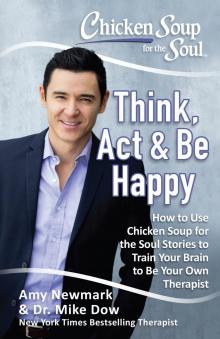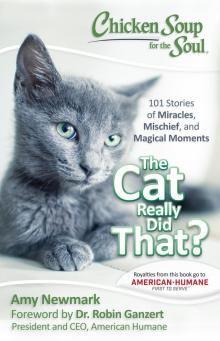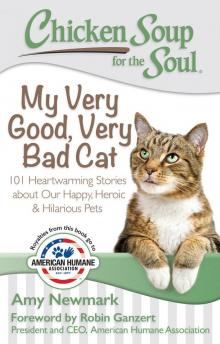- Home
- Amy Newmark
My Very Good, Very Bad Dog Page 4
My Very Good, Very Bad Dog Read online
Page 4
Spring had sprung, and Sarah and her husband built a play fort in the back yard for the kids to play in while they planted flowers in the flowerbeds. I noticed that when I was cooking in my kitchen and the kids were playing next door, Lacey would cry to go out. I’d let Lacey out in the back yard while I was finishing supper and I would hear the squeals of laughter from Kim next door when she caught a glimpse of Lacey. When the kids were playing, it got harder and harder to get Lacey to come back in the house.
One afternoon, Lacey did not come back at all when I called, and it was eerily quiet in the neighbor’s back yard. Wondering if something was amiss, I dried my hands and went into the yard to see what was happening. As I cleared the corner of the house and looked in the direction of our neighbors’ house, I witnessed what was going on just about the time Sarah looked up from her flowerbed to check on her suddenly silent toddler.
There, both clinging to the chain-link fence that separated them, were Lacey and Kim. They had each pulled up to the eye level of the other and were intent on joyfully touching tongues through the links of the fence. Sarah and I simultaneously started laughing and went to separate our “kids.”
~Janice R. Edwards
Pet Rock
Fun fact: Mother dogs are called dams. Father dogs are called sires.
We grew up on a farm in Colorado, situated at the base of the Rocky Mountains, surrounded by cats, goats, pigs, cows, and horses. My sister and I loved the outdoors, and our dog Kelly was our constant companion. Her fat belly and long ears almost dragged on the ground as her little legs labored to keep up with us. The only thing that took precedence over tagging after us was chasing rabbits. When she picked up a rabbit’s scent, she’d follow it, yipping, with her nose to the ground. Sometimes she’d be gone for hours. One time, she actually came back carrying a bedraggled baby bunny.
“Kelly, no!” Alarmed, I took the baby bunny away from her. Not knowing what else to do with it, I took it home and placed it in a cage. I would try to raise it and release it back to the wild.
In the spring, my sister and I often ignored Kelly for a while when there was a new litter of kittens, a nest of baby bunnies, or a new baby calf. One day, as we stopped to inspect a litter of kittens, we noticed that the gray striped one was missing. The mother cat had been known to move previous litters, so we searched all the places where she had hidden them before. We came up empty. I decided to search in one last place — a rarely used shed. Peering into the gloom, I heard a crying kitten, and who did I find there but Kelly, lying next to the kitten. She looked up at me and thumped her tail, smiling, as if to say, “See? I’m taking care of her.”
I gently scooped up the kitten and carried it back to its mother. A few days later, the same kitten went missing. Again, my sister and I found Kelly nestled in the shed with it. This earned her a stern scolding as we carried the kitten back to its mother.
All summer long, we battled — Kelly stealing a kitten, my sister and I hunting her down and taking the kitten away. It didn’t matter how much we scolded her, Kelly continued to steal the kitten, bathing it and trying to nurse it. For the next three springs, Kelly, my sister and I fought that same battle with a new kitten every year. Then one year, we stumbled across a goose nest. Canada Geese migrated through every year, but this was the first time we’d actually found one of their nests.
“No, Kelly, no!” we told her as we shoved her away from the nest. A few days later, I saw her coming from behind the house, carrying something in her mouth.
“What does she have now?”
She had robbed the goose nest! I looked at her in exasperation, but didn’t try to take it away. I doubted that the mother goose would want her egg back.
Kelly carried her goose egg around with her all summer. She would stop and gently lay it down to follow my sister and me when we went horseback riding, swimming, or fishing. But upon returning to the house, she would go straight to check on her goose egg, gently pick it up, and carry it to a new resting spot. She totally ignored the kittens.
Then one day, as I was going around the back of the house, I spotted Kelly standing with her legs splayed, head hanging down with the saddest look on her face.
“Kelly, what?” I started to say, but then the smell hit me. Gagging, I whirled and hurried away. When I came around the other side of the house, I stopped, gulping in fresh air. Yikes! I didn’t know which smelled worse — rotten egg or skunk! They were both foul. When I could breathe again, I found my sister and informed her that Kelly had dropped her goose egg. We both tried to console Kelly when she finally joined us. I don’t know if dogs can actually cry, but it sure did look like a few tears actually slid out of her eyes, although maybe it was just a reaction to the noxious smell. After all, she’d been standing right over the egg when it broke!
For a while, it seemed that Kelly had given up on having her own baby. She now ignored tiny kittens, baby rabbits, and eggs of any kind. But that was soon to change. My dad drove us up into the mountains every Saturday during summer vacation, and we spent the day exploring. I was a rock hound, fascinated by all the different quartz crystals and mica flakes I found.
One day, I rounded a boulder and came upon Kelly digging and worrying at a rather sizeable moss-covered rock. “What did you find, Kelly?” I asked as I knelt to help her move the rock, expecting to see something interesting underneath it. Finding nothing, I left her to her rock and continued with my own hunt for mica. When my search brought me past her again, she was still pawing at the rock, trying to get it into a position where she could pick it up. I watched as she tried several times, her neck muscles bulging with the effort. “You silly dog, you’ll never be able to pick that up,” I told her as I hunted around for a smaller rock. “Here, try this one.” I handed her a rock slightly larger than my fist that fit in her mouth nicely. Wagging a thank-you, Kelly picked up the rock and followed me back to the car.
When we arrived home, Kelly tried to carry her rock everywhere she went. Deciding that was too cumbersome, she settled for just bringing it out when we were around the house. She had finally found the perfect pet! It would not die, break, or be taken away.
When the Pet Rock craze hit the shelves a few years later, I laughed to myself. After all, my dog Kelly, a pudgy Dachshund with overly long ears and chestnut brown eyes, was the proud owner of the Original Pet Rock.
~Karen Cooper
My Miraculous Dog
Fun fact: According to legend, dogs and other animals are given the miraculous ability to talk at midnight on Christmas Eve.
The Rainbow Bridge
Fun fact: Cocker Spaniels were given their name because they were good at helping people hunt the woodcock, which the Spaniel flushed out of low bushes.
Ten years ago, my father was seventy-one, but still not retired. He had always taken great pride in his work and defined himself by it, so, to his mind, retirement equaled uselessness and loss of identity. My mom was growing increasingly resentful at being left alone so much during what were supposed to be their golden years. I suggested to her many times that she get a dog for company around the house, but she always said, “We don’t want the carpets to get ruined.”
I tried to convince my parents that a little carpet damage would be a small price to pay for the loyal companionship of a dog, but they still refused. Their last dog was my childhood pet, which had died twenty years earlier, so I figured they were overdue for another one. My plan was to find a puppy so cute they couldn’t possibly resist it. Of course, every puppy is adorable, but the one I found was off the charts — a Cocker Spaniel smaller than my hand, with long, silky ears and big, brown, soulful eyes.
The only problem was that it would pee when I leaned over it or picked it up. As I wiped off my hand, the breeder said, “Oh, that’s just submissive urination. He’s recognizing your dominance. It’s kind of a compliment!”
It didn’t feel like a compliment. It felt like pee.
He added, “It’s a puppy thing. It’ll stop when
she’s older.” I took his word for it, figuring a little wee-wee could be tolerated for such a bombardment of cuteness. Armed with this secret weapon, I returned to my parents’ house. My mother fell easily, but my dad remained stony. While my mother cuddled and spoke baby talk to the puppy, he leaned in and whispered to me, “I’ll get you for this.”
In his younger years, my dad was a semi-professional boxer and a reserve policeman in Belfast, Northern Ireland. He was as tough as his upbringing, but he had a soft side, too. I often joked with him that he was “rock candy with a gooey center” — tough on the outside but mushy on the inside.
In time, as I had hoped, the dog did her magic and won him over, too. They named her Molly, and she became my dad’s constant companion. I think she was even instrumental in helping him finally retire. It was still hard for him to sit around the house, but having Molly to play with made it much easier. My mom was happier than ever, too.
A few months after I gave them Molly, Dad told me, “That dog is the greatest gift you’ve ever given us.”
I joked, “But, Dad, you said you were going to get me for this, remember?”
He smiled slightly and said, “Shut up.”
Molly filled their days with laughter and slept at the foot of their bed every night. They walked her several times a day, getting exercise they otherwise wouldn’t have had, and meeting neighbors they might never have met.
Five years ago, my father was diagnosed with light forms of Parkinson’s and dementia. He became very depressed. He even stopped singing, the one thing that had given him the most joy in life. We all felt helpless. He had always been the life of the party, the one his friends called on to sing a song or tell a joke, and so the change was painful to watch. I visited him as often as I could, but work and family obligations often kept me away. I was always glad to know Molly was with him when I couldn’t be.
Last year, on the day after Thanksgiving, Dad fell and fractured his hip. He spent three agonizing weeks in the hospital. Since my wife, my mother or I were always at his bedside, we took turns going home to tend to Molly. She always greeted me enthusiastically and then looked out the window to see if my dad was with me. I would tell her he would be home soon. One day, I entered the house so quietly she didn’t hear me come in. I found her sleeping on his pillow.
My father never came home. He developed aspiration pneumonia in the hospital and died of respiratory failure a few days before Christmas. We fought hard to save him because there was still a lot of him left to save, despite his brain conditions. The day before he broke his hip, we had had Thanksgiving dinner and he was very much his old self, so it was devastating to lose him.
When I took my mother home, Molly greeted us as enthusiastically as ever, and then looked out the window again for my dad. My mother sat on the couch and cried. Molly looked over from the window, then ran and jumped onto my mother’s lap, lowered her head and actually seemed to cry with her. She knew something was very wrong.
It was a dark house for several days when tragedy struck again. Molly, who was only ten years old and had always been perfectly healthy, died suddenly of a brain aneurysm on Christmas Day, four days after my father’s death. My mother was inconsolable.
Some say everything happens for a reason, but for the life of me, I couldn’t figure out why my father had to suffer so much during the last three weeks of his life, and why their dog had to die a few days later and leave my mother completely alone. It just seemed cruel and senseless.
A few weeks later, I was talking with a good family friend; Kathleen asked if I had ever heard of the “Rainbow Bridge.” I hadn’t. She said, “It’s a place between earth and heaven where animals wait for the person they were closest to. The Bridge is in a beautiful place with fields for dogs to play in and everything they could desire. Sometimes, the animal dies before its owner, and sometimes they die because they know their owner has passed away and they want to find him or her again. Your dad may have been confused and in need of a guide. The dog is there to lead its master over the Rainbow Bridge and into heaven.”
I was very cynical at the time because of so many unanswered prayers in the hospital, but I hoped that this was true. When I doubt the existence of the rainbow bridge, or heaven itself, I remind myself that a healthy dog somehow knew my father was not coming home and died a few days after he did. I remind myself that my dad had a brain condition, and Molly died of one, as if by some empathetic response, and as if she knew dying was the only way to be with him again. It seems to me life can be meaningless or it can be filled with magic and great mysteries. I choose a mystery.
My four-year-old daughter asked where my father and Molly went. I didn’t want to explain death to her so early, so I told her they both went to Ireland. I imagine the land around the Rainbow Bridge is a lot like Ireland, so it’s a white lie.
Someday, when I’m old and it’s my time to go, I hope the dogs I’ve loved on this earth will guide me across the Rainbow Bridge, too. And I hope my father and Molly will be waiting for me on the other side, happy and healed. I’ll hold him tight, then kneel down and tussle Molly’s hair like I always did. She’ll look at me with those big brown eyes and her doggy smile again. My father will put his arm around me and say, “Isn’t this something, son? It’s all true! And Molly is still the greatest gift you ever gave me.”
~Mark Rickerby
Listening to Our Hearts
Fun fact: Most experts agree that dogs dream. They may also grunt or jerk while sleeping because they relax their muscles when they’re asleep, just like people.
Daisy was stuck on her back, her legs rigid in the air, her big brown eyes filled with fear. She was a black Labrador mix, only six-and-a-half years old, and always happy and cheerful. She had trotted into the back yard and we found her five minutes later, unable to move. All she could do was move her head a little.
The veterinarians confirmed that Daisy was paralyzed from a sudden stroke and suggested that we give her the weekend to heal. If she wasn’t walking by Monday, we were told to think about her quality of life. We had a large dog cot and placed Daisy on it, keeping a soft pillow beneath her head. We put puppy pads on the bottom half of the cot, as she had no control over going to the bathroom. We hand-fed and watered Daisy — she couldn’t lift her neck to do so for herself. We bathed her daily and flipped her to lie on the opposite side every hour or two to prevent bedsores, including during the night.
Monday came and went, but we opted to wait. We didn’t want to give up on Daisy so soon. After extensive online research, we found that many dogs had suffered this type of stroke and had a nearly full recovery, although it often took at least six weeks for the improvement to become evident. We were definitely waiting. Daisy still wagged her tail as she lay on her cot. Her eyes were still vibrant. Mentally and emotionally, she was the same happy Daisy she had always been — she just couldn’t move.
We provided Daisy with daily range-of-motion therapy and massage. We carried all fifty-three pounds of her on her cot up and down the stairs to be with us wherever we were in the house. She was just as much a part of our life as she had always been, despite being paralyzed.
Three weeks went by, and there was little improvement. Then she developed a bad urinary tract infection. Her urine filled with blood, and we worried that she was shutting down internally. Thankfully, after testing and medication, Daisy’s infection healed. The nights remained sleepless, however.
After five weeks of around-the-clock care, Daisy began to run in her sleep. She still had no feeling or motion in three legs, but we thought the sleep running (most likely dreaming about running) was helpful for her muscles to regain the memory of movement. Instead of waking her up, we let her dream, hoping that the movement produced in her dreams would one day translate into reality.
Around the five-week mark, we bought a large rug for Daisy. We called it the therapy rug. In addition to daily range-of-motion therapy and massage, we thought that providing her with a large area rug would give
her a location with traction — a place to pull herself around if and when she was ready.
We laid out the therapy rug and carried Daisy from her cot onto the carpet. Daisy wagged her tail in appreciation, and within a day of the rug’s arrival, she began trying to pull herself forward. We still had no idea if she would regain feeling or strength in her three legs, but we held onto hope.
At exactly six weeks from the date she became paralyzed, Daisy attempted to walk. We had a fresh snowfall — good packing snow — and we decided to carve a narrow passageway in the snow. Its sides would support Daisy’s body as she stood. Daisy stood on all four legs for the first time in six weeks with the help of our self-made snow bumper walls. This was a huge victory, and we knew at this point — although we still had a long road ahead of us — there was no turning back.
From six weeks on, Daisy began to use the bathroom outside. We bought multiple area rugs, and she could pull herself to her food and water bowls anytime she wanted to. The transformation was miraculous. We had a set of wheels made to support her back end as she re-learned how to walk. However, Daisy was determined to walk on her own. We never pushed her to try; we only encouraged her when she did. We knew this wasn’t something that could be rushed. We did our part with the ongoing care and therapy, and we took it one moment at a time.
Before we hit the seven-week mark, Daisy took off — running! It was far from graceful, but she was running and doing it totally on her own. In the days leading up to this, she had been merely pulling herself a few steps or standing for a few seconds before falling over. Now she was running!
Although the situation had looked hopeless when Daisy first became paralyzed, we listened to our gut — and our gut said to do our own research. Daisy was fully alert, mentally and emotionally, even just after becoming paralyzed. She had the will to live. And so, after researching and listening to our hearts, we moved forward, helping Daisy regain mobility and strength.

 Chicken Soup for the Soul
Chicken Soup for the Soul The Joy of Less
The Joy of Less Hope & Miracles
Hope & Miracles The Cat Really Did That?: 101 Stories of Miracles, Mischief and Magical Moments
The Cat Really Did That?: 101 Stories of Miracles, Mischief and Magical Moments The Joy of Christmas
The Joy of Christmas My Very Good, Very Bad Dog
My Very Good, Very Bad Dog My Very Good, Very Bad Cat
My Very Good, Very Bad Cat